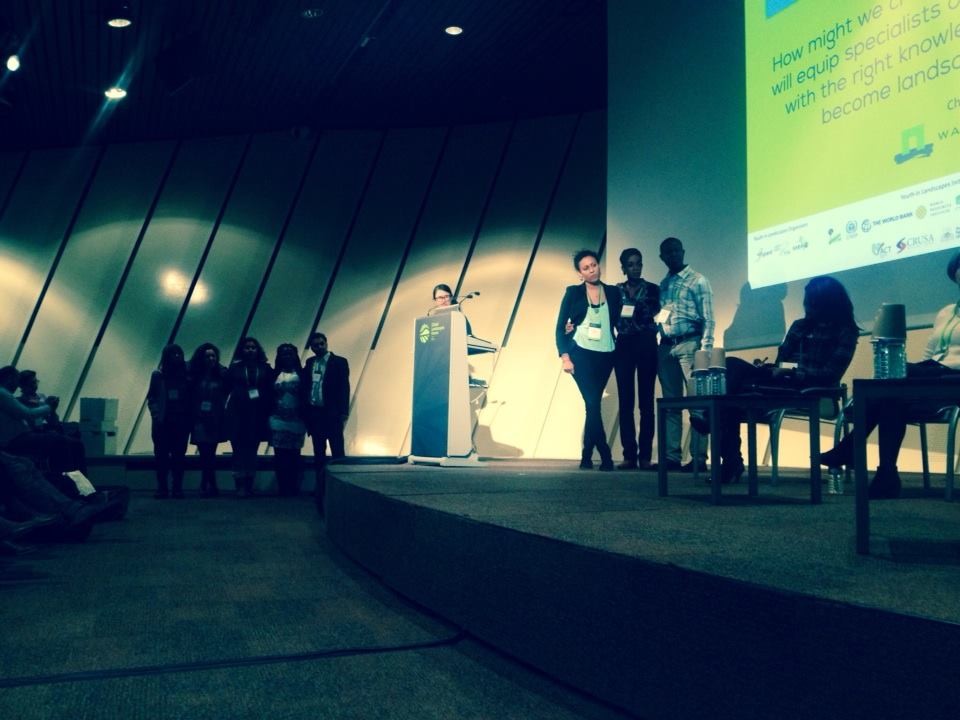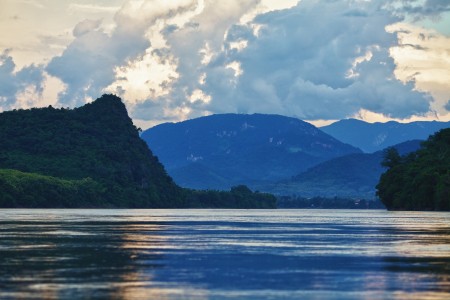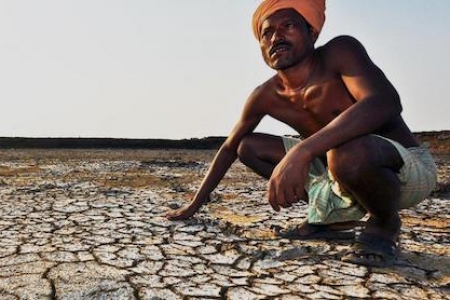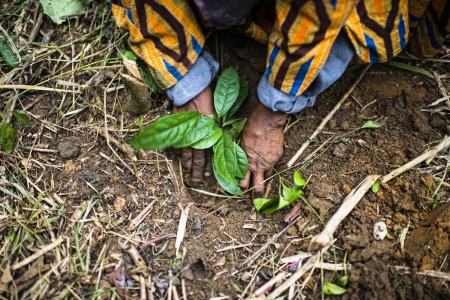Imagine walking onto a stage in a room full of 200+ people, in front of a panel of renowned experts, and pitching a solution that you and a group of 10 peers from around the world developed in four short days. And you speak English as a second or third language.
For four days, 50 young innovators worked on solutions to landscape challenges defined by five organizations as part of the Youth in Landscapes Initiative. On Sunday, they took the stage at the Global Landscapes Forum, the largest parallel event to the COP21 climate talks, and pitched their solutions to a panel of experts in a “Dragons Den” session. Without fail, they left the audience in high energy and spirit at the end of an intense weekend conference.

My heart was racing throughout the entire event. After each pitch, you could almost feel the teams holding their breaths as they waited for the dragons to respond.
I had a particularly vested interest, among the audience members around me, in the success of each pitch, as I had attempted to guide the teams earlier in the week on best practices of pitching. The pitchers were nervous, their teams were standing by their sides in support, and the dragons were spot on with many of their comments. But I was pretty sure that I wasn’t the only one in the audience who shared a bit of the nervousness of the other pitchers.
Mia Signs, Master of Ceremonies, opened the session with an invitation to the audience: “we have a room full of dragons”. Everyone in the room now had a role to play. The audience received cards on which they could write feedback for each group and were invited at the end of the session to discuss their comments.
In case you missed it, here’s a window into the event.
Enter the Dragons Den
Meet the five “dragons” (i.e., panelists):
- Bernard Giraud, Senior Sustainability Advisor of Danone and co-founder of Livelihoods Fund
- Steven Lawry, Director of governance research at the Centre for International Forestry Research (CIFOR)
- Kemi Seesink, Policy and Advocacy Coordinator of the Global Water Initiative
- Tint Lwin Thaung, Executive Director of The Centre for People and Forests (RECOFT)
- Catharine Watson, Head of program development, World Agroforestry Centre (ICRAF)
In his opening remarks, Bernard Giraud, shared a humbling story of pitching from his early days with Danone. When he was invited to pitch a proposal to a group of senior executives, he recalled: “I was very excited, I brought what I considered as great ideas and a great proposal. But it was a total failure. My colleagues were puzzled with what I proposed.”
He left the pitchers with some parting words of advice before they began:
“I realized that when you pitch to someone, you have to understand the culture and understand how your proposal has to fit in with what they can really implement.”
Round 1: Measuring Success
The first pitch was from the Measuring Success group on a tool to evaluate the effectiveness of digital learning tools that have become quite popular in development projects. “We are open, transparent and community driven; we recognize the importance of scientifically-based, data driven analysis,” they said. The tool, they noted, could be particularly useful for nations monitoring the Sustainable Development Goals.
The dragons weighed in:
Seesink commented, “Good audience engagement, you didn’t rattle off acronyms without defining them…..but I don’t yet know, why YOU?”
Watson: “Show me it was an innovative idea, don’t tell me. How is it different from what’s already out there.”
With a few more persuasive words, this group had the dragons just about convinced.
Round 2: Landscape Restoration
The second pitch came from the Landscape Restoration team. Under the mentorship of Dr. Alan Nicol of the International Water Management Institute, the team focused on developing a “cost-effective” solution to Ethiopia’s land degradation challenge under the Four Basin Gender Profiles Project. “There is a need for data from organizations working on the ground. We prepared a people centered tool kit for land restoration,” they explained to the dragons.
And the dragons responded:
Thuang: “In landscape restoration, it is difficult to bring together different sectors. I want to make sure you will apply this tool to as many people as possible.”
Giraud caught on to the “people-centered approach”: “If people are at the center of your toolkit, how does it work? Data collection is sometimes very impressive but data used by people is much more interesting.”
Seesink, wearing a number of different hats (Nile Basin Initiative and Global Water Initiative), wanted to know: “what makes this cost-effective?” But she continued, “yes if you’re asking us to integrate it [the toolkit] into our projects, then yes, that’s interesting and worth considering.”
With that final remark, the team could walk away satisfied knowing there was a stated interest in testing the tool.
Round 3: Education
The third pitch was from the Education team. They pitched a tool to help people determine which skills they need to work in landscapes. The tool could be used within a Landscape Academy, which is currently under development by Wageningen University. By going through the online assessment, candidates for the Academy would be able to determine which curriculum would be most beneficial to compliment their existing knowledge and experiences.
They ended their pitch with a strong call to action: “We urge you to make use of this landscapes academy. The landscapes train is moving; get on board!”
And the crowd responded with a roaring round of applause.
The team put their arms around each other as they listened to the dragon’s feedback.
Lawry: “You have the energy and you found the right words to convince me.”
Seesink: “I’d like it to become a stop train instead – it stops at the stations and considers who it takes on and off…Where are the extension services? Where is the farmer to farmer? I’m hearing a lot of excitement and a lot about effectiveness but not a lot about efficiency. PRESENT the numbers.”
By the end of this third round, the rhythm had been set. Audience members were buzzing as they wrote down their last few sentences of feedback.
Break: Competition Winner
During the session break, Tamanda Chabvuta from Malawi was announced the winner of the youth in landscapes video contest. She won a professional development training with Pamela Yieke of AWARD.
Watch the video.
And then the final two pitches…
Round 4: Finance and Trade
The fourth pitch was from the Finance and Trade group. They used their personal stories to convince the dragons:
“We are smallholder farmers and we live and breath these challenges,” they started. “I’m a smallholder farmer in Kenya and through my experience, I was able to travel from Kenya to Norway to learn from a dairy farm…I was able to increase my production.”
They directed their pitch at Giraud, “We are asking that you commit a portion of the fund [previously established by Livelihoods] to an exchange program for smallholder farmers to learn directly from each other – we believe it will improve livelihoods of farmers!”
Giraud was first to respond: “How can you build trust between smallholders and companies? I think going abroad to see large efficient farms is great, but don’t you think you should also explore how companies can engage in how to support small cooperatives?”
Seesink: “I do think it would be interesting to hear more about the innovation in the finance mechanism. Are there elements related to resilience or micro-credit? I’d like to hear more”.
It’s always satisfying to hear, “I want to hear more.” After the dragon’s den, the team had a chance to speak about their solution with Giraud. Through the knowledge exchange, the group believes farmers will share their knowledge with their communities, leading to an organic formation of cooperatives.
Round 5: Rights and Tenure
The final pitch from the Rights and Tenure group presented a solution for monitoring REDD+ safeguards to respect local rights and promote local livelihoods. “We’re allowing communities to define their own indicators,” said the pitchers. Data could be collected and shared via an interactive map between civil society organizations, communities, and national governments.
“We ask national governments to consider these mechanisms because we believe this is an efficient software system to promote local livelihoods,” they concluded.
The dragons responded with Lawry of CIFOR providing comments first: “In concept this is very compelling. One of the challenges of meeting the safeguards is local participation and feeding it up into the national system for reporting and policy purposes.” But Lawry felt that the group should also find a way to address or document land rights, which will be a critical step to achieve prior to the safeguards, to which Thaung agreed.
Watson asked, “How can you capture qualitative data?”
Youth voices are heard
Through events like this, one thing that I think we youth are trying to show is that we are not only craving ways to get our voices heard, but we have innovative ideas to bring to the table. It’s about finding the right space at the right time to be heard.
This sentiment was captured quite magnificently by one of the young innovators, Salina Abraham, in her closing remarks during the final GLF high-level plenary.
“We need your wisdom, your guidance, your investment. But I’m here to tell you – you may not know it – but you also need us too.”












